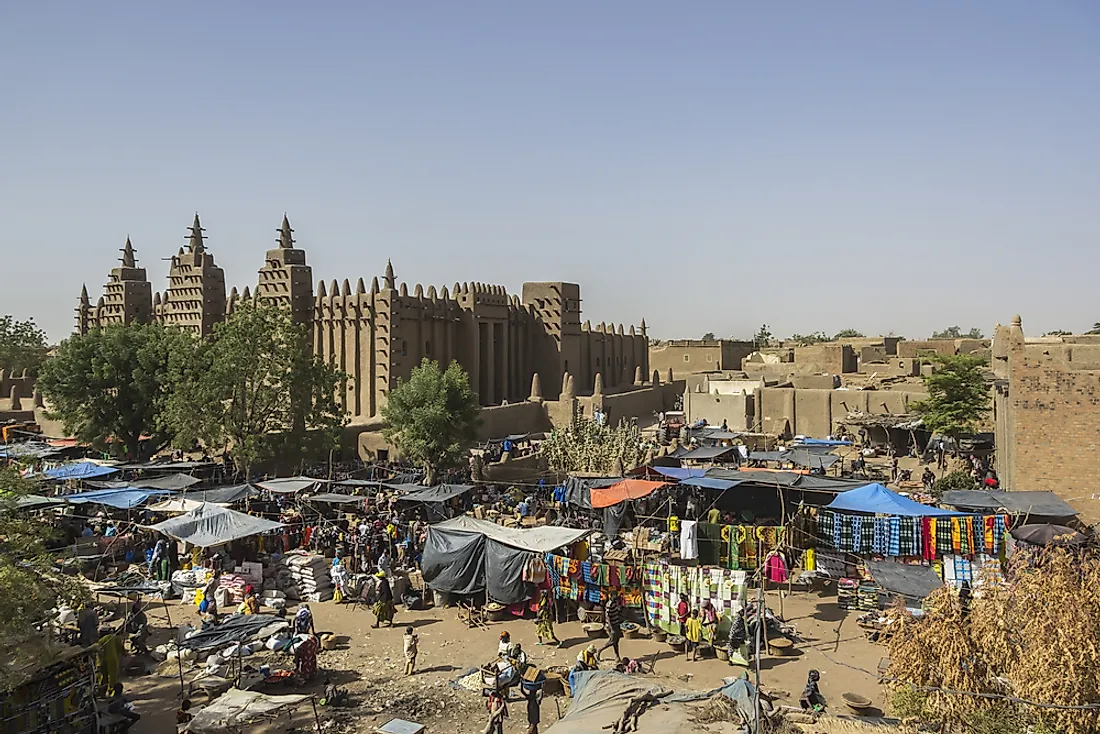The Culture Of Mali

Located in western Africa, Mali is home to a population of approximately 19,329,841 people and gained its independence from France in 1960. Mali has a unique culture that includes traditions and rituals passed down through the ages from generation to generation.
6. Religion
Mali is an Islamic nation with the majority of its citizens identifying as Muslims. According to estimates from 2008, some 90% of the country’s population ascribe to the Sunni Muslim faith. Minority religions in the region include Christianity which is the religion of approximately 5% of the population. 1.5% of Christians or about 200,000 residents identify as Catholics while the remainder belong to Protestant denominations. Another 10% of Mali's population follows a variety of traditional African religions. It’s believed that the Islamic religion came to Mali sometime in the eight century and blossomed in popularity during the time when the region became a French territory late in the 19th century.
5. Festivals
Mali is home to a number of popular cultural festivals including the Diamwari, Desert, and Gouin Festivals as well as the Festival on the Niger. The Diamwari Festival takes place over three days near the end of February. Set on the banks of the Bani River, this annual gathering is a celebration of happiness and features large puppets, performances by a variety of local dance troupes, and Dogon masks. Mali’s Desert Festival also takes place in February and focuses on music. Once a traditional Tuareg celebration, the festival has evolved over the years to become an internationally recognized musical event of peace. Mali’s Gouin Festival is held in January over the course of three days. The celebration is populated by jazz and Goumbé musical performers along with several Kayes dance groups and lively appearances by local wildlife including hippos and monkeys. The Festival on the Niger includes boat races along the Niger River. The fest also includes an abundance of music, dancing, crafts, puppets, and art shows.
4. Cuisine
Staples of the Malian diet include cereal grains such as rice and millet. Local dishes are prepared using grains and a variety of sauces prepared from ingredients such as tomatoes, peanuts, spinach, sweet potato, and a native species of tree known as the baobab. Types of meat consumed in Mali include mutton, beef, goat, and chicken. One of the country’s main dishes, known as Fufu, is a type of porridge containing Cassava, a commonly found edible shrub. Another popular dish, maafe, is a stew which is made up of some type of meat along with tomatoes, onions, garlic, cabbage, leaf or root vegetables, and peanuts. Jollof rice is another popular local "one pot" dish. Although the specific ingredients may vary from region to region the basic recipe includes rice, chili peppers, tomatoes, tomato paste, oil, onions and salt along with various spices which may include garlic, cumin, nutmeg, and ginger. Other ingredients including meat, fish, and other vegetables may also be added. Popular local beverages in Mali include dabileni which is made from water, sugar, and sorrel (a herb) as well as jinjinbere a drink combining water, lemon, sugar, and ginger.
3. Music And Dance
The ethnically diverse musical traditions of Mali are heavily influenced by the ancient Mali Empire of the Mandinka which dates back to sometime between the years 1230 and 1600. The Mandinka are the cultural ancestors of the Mande people of the region. This ethnic group now makes up about half of Mali’s total population. Professional Mande musicians and singers, known as jeliw, use traditional instruments such as the kora (which resembles a 21 string harp), xylophones (also called balafon), and lutes (known as Ngoni). Popular musical performers in Mali include Oumou Sangaré, a Wassoulou musician, and singer and guitarist Vieux Farka Touré. Dancing also plays a significant role in the culture of Mali. Locals often take part in dance parties as well as take part in traditional mask dances during various ceremonies and special events.
2. Literature
Mali is known more for its musical traditions than its literary works. Traditionally most of Mali’s literature has been communicated orally and thus passed down from one generation to the next. Perhaps the most important literary genre in terms of the important role it has played in shaping (or at times reshaping) Mali’s history is that of epic. Writers have used this particular genre as a means of helping to define the country’s national identity as well as in order to provide relevant social commentary. Among the country’s most well-known writers include Yambo Ouologuem, Moussa Konaté, Fily Dabo Sissoko, and Massa Makan Diabaté. Popular books from Mali include titles such as “Sundiata: An Epic of Old Mali” as told by Mamadou Kouyaté and translated by Djibril Tamsir Niane, “Segu” by Maryse Condé and translated by Barbara Bray, and “Amkoullel, l'enfant Peul” by Amadou Hampâté Bâ.
1. Social Belief And Etiquette
Even though Mali is an ethnically and linguistically diverse country, its social structure is heavily influenced by traditional Islamic religious beliefs. Females living in Mali are subject to social, political, and economic domination by their male partners. Under this traditional patriarchal system violence towards women is common and adult women and girls must conform to strict gender roles. Women are seen as wives and mothers while men hold positions of authority and reign over their households as head of the family. Local residents of this African nation are known for their hospitality in terms of how they treat both visitors and fellow citizens alike. Respect for one’s elders as well as the giving of gifts are key aspects of social life in Mali. Marriage plays an important role in the social structure of Mali. Modern matrimony may take a variety of forms depending upon the couple (and families) involved. These include traditional, civil, or religious marriages. Children often must undergo gender based initiation rites not long after they are born. These traditional practices include circumcision for males and clitoridectomy for females.











